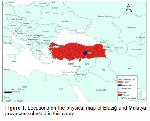The Bluetongue disease was first described in South Africa in the early 19th century. The first well-documented epizootic of BT outside Africa appeared amongst sheep in Cyprus in 1943
17. This disease was first clinically described in Hatay province in Türkiye's border region with Syria in 1944
18,19. The first officially defined outbreak of BT in Türkiye emerged in the province of Aydın in 1977 and spread to the neighboring provinces of the Mediterranean and Aegean between 1977-1979, creating an endemic. BTV-4 was the first serotype isolated from infected sheep in Türkiye and whose circulation was proven by serological tests
20. Then, this endemic was controlled by applying strict measures such as quarantine, animal movement control, disinfection, insecticide treatment, and vaccination (attenuated live vaccine, against BT-4)
21. Taylor and Melor
20 reported the presence of neutralizing antibodies against BTV-2, 4, 9, 13, and 15 in different animal species (ox, goat, sheep) from the Central Anatolian, Aegean, and Mediterranean regions of Türkiye from 1980 to 1981. In 1998, after 20 years of absence in Europe, BTV outbreaks occurred simultaneously in southern and western Anatolia. While BTV-9 was isolated from infected animals in Thrace during the epidemic that lasted for several years, BTV-16 was also isolated from infected animals in western Türkiye in 2000
21. In Türkiye, the herd seroprevalence varies among geographic regions, but the percentage ranged from 1 to 91 (19; 22; 23). Ozgunluk
24 found 52.58% seropositivity against BTV-4 in cattle in the southeast Anatolia region. Yildirim and Burgu
25 reported that the rate of neutralizing antibodies to BTV-4 in cattle in 8 provinces (Igdir, Agri, Kars, Erzurum, Bayburt, Gumushane, Artvin, Ardahan) in northeastern Türkiye was 48.02%. According to the results of the study conducted by Karaoglu et al.,
26 in cattle in Thrace, the seropositivity rate for BTV-4, BTV-9, and BTV-16 was over 69%. Yildirim and Yilmaz
23 detected neutralizing antibodies against BTV-4, -9, and -16 serotypes in cattle in three provinces (Ardahan, Iğdır, and Kars) in northeastern Türkiye, and overall seroprevalence was quite high (91.7%) in the same study. Karaoglu et al.,
27 determined the presence of BTV-9 circulation in the farm at the sampling time in the Southeast Anatolia region, according to the results of the SN50 test for BT-4, BT-9, and BT-16 in herds in the northeast and southeast Anatolia. Ozgunluk
28 detected 64.24% seropositivity with the serum neutralization test in cattle in Aydin province in the region of Türkiye and found neutralizing antibodies against BTV-4, -9, and -16 serotypes. Erturk
19 detected 34.4%, 15%, and 1% seropositivity in sheep, goats, and cattle in 21 provinces of Türkiye by agar-gel precipitation test, respectively. Ozturk et al.
29 found 36.04% positivity with the microneutralization test in sheep in Konya province in the Central Anatolian region. According to ELISA results, which Bulut et al.
22 found more sensitive than SNT, the seroprevalence of BTV in sheep and goats in Konya province was 17% and 60%, respectively. In the same study, this rate was 1.5% and 60% for sheep and goats in Burdur province. Yigit
30 found 10% seropositivity against BTV by c-ELISA in sheep in Konya province. BTV seropositivity in Kars province in eastern Türkiye was 10.65% and 15.5% in sheep and cattle, respectively, according to the results of two studies conducted at different times
31,32. Celik and Sahin
33 detected 73.12% BTV seropositivity in sheep in Siirt province in eastern Türkiye. Gur
34 found BTV seropositivity of 24.8% in sheep in Afyonkarahisar province. Azkur et al.
35 reported that BTV seroprevalence was 49.8% in sheep in Kirikkale province in the Central Anatolian region. Albayrak and Ozan
36 reported that BTV seropositivity of cattle and sheep in five provinces (Samsun, Sinop, Ordu, Amasya, and Tokat) in the Black Sea region was 11% and 3%, respectively. Kulac et al.
37 detected 25% seropositivity in cattle in Rize province in northeastern Türkiye. Ozgunluk and Cabalar
38 reported that BTV seroprevalence in sheep and goat herds in Sanlıurfa province in southeastern Türkiye was 87.50% and 81.17%, respectively, using the agar-gel immunodiffusion method (AGID). Simsek et al.,
39 reported that the seroprevalence of Bluetongue disease was 17.43% in animals with digestive and respiratory system disorders in Diyarbakir province. Pestil
40 determined 38.7% BTV seropositivity in abortion and postnatal cases in sheep in the Marmara region. Pestil et al.,
41 determined 53.5% BTV seropositivity in camels in 7 provinces of Türkiye (Antalya, Aydin, Canakkale, Denizli, Izmir, Muğla and Sanliurfa). Since Türkiye is an important gateway between the continents of Europe and Asia, epidemiological studies are of great importance and outbreak reports are followed closely by Europe and the OIE. Studies on the prevalence of BTV in Türkiye's Elazığ and Malatya provinces are limited. Bolat
42 reported with the AGID test that the seropositivity of sheep in Elazığ province was 33.25% and the overall seroprevalence was 21.32% in 8 provinces, including Elazığ in central, eastern, and southern Anatolia. In this study, we found the BTV seropositivity to be 10% and 0% for Elazığ and Malatya, respectively, while the overall seropositivity was 5.38%. Serotype determination in seropositive animals may reveal that the current BTV strain is typical or atypical form, but this was not performed in this study. The most likely vectors of BTV in western Türkiye have been identified as Culicoides imicola, C. obsoletus, and C. schultzei
21. It is known that there is a culicoides population in the region where the study was conducted
16, but there is no study that has been identified. Although this is a small-scale study, the current data obtained will contribute to the epidemiology of BTV in Türkiye, but more detailed studies are needed in this region.




